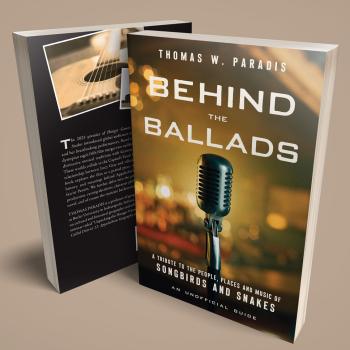 Criticisms from outside are easily dismissed. Those who criticize us in this way, we can reassure ourselves, simply don’t like us, or they are fundamentally opposed to our beliefs and values. Criticism from within a tradition or movement, for this reason, carries greater weight. And although Nichols’ book is described as a “cultural history”, like so many works of history, it is not an attempt to be comprehensive (although the small volume’s sweep is certainly broad), but to make use of the study of history to provide warnings and lessons for the present (p.14). “This survey of the American evangelical Jesus intends to do more than inform. It intends to raise significant questions about the state of Christology in American evangelicalism” (p.17).
Criticisms from outside are easily dismissed. Those who criticize us in this way, we can reassure ourselves, simply don’t like us, or they are fundamentally opposed to our beliefs and values. Criticism from within a tradition or movement, for this reason, carries greater weight. And although Nichols’ book is described as a “cultural history”, like so many works of history, it is not an attempt to be comprehensive (although the small volume’s sweep is certainly broad), but to make use of the study of history to provide warnings and lessons for the present (p.14). “This survey of the American evangelical Jesus intends to do more than inform. It intends to raise significant questions about the state of Christology in American evangelicalism” (p.17).
Nichols’ criticisms of his own conservative Evangelical tradition are on the whole fair and balanced, as for the most part is his treatment of others in the broader picture of American Christianity. Nichols manages to offer insightful and relevant critiques of aspects of contemporary American Christology that seem to him at best shallow and at worst dangerously wrong, while not losing his sense of humor along the way. Although there are points at which I think Nichols’ criticisms of other viewpoints could have been applied to his own to a fuller extent that Nichols indicates, there is no author without blind spots and presuppositions. What Nichols offers in terms of a self-critical analysis is impressive, and I highly recommend his book for evangelicals interested in engaging their culture and examining their hidden assumptions in a deeper way than is commonly found. For those who are either outside of evangelicalism or are not on the conservative end of the evangelical spectrum, Nichols will make an engaging dialogue partner with whom there will inevitably be disagreement, but also much to appreciate.
The introduction sets up the book’s aims and key themes, and summarizes the points and arguments that will follow in subsequent chapters. The introduction opens with a reference to the famous American preacher Billy Sunday having once said in a sermon that if one turns hell upside down, one will find “Made in Germany” stamped on the bottom (p.9). While there is a connection between Germany and higher criticism on the one hand, and the erosion of confidence in the Bible during the course of America’s history on the other, Nichols points out that there have always been American equivalents to European critics, and that when one considers not only these but other distinctive aspects of American Christianity (whether liberal or conservative), the label “Made in America” clearly is also not to be ignored. On p.13, Nichols acknowledges several other recent studies of American Christianity and in particular American views of Jesus, and clarifies how his book differs on p.14, emphasizing that his focus is on American evangelicalism and its view of Jesus.
 “Jesus, like most cultural heroes, is malleable,” writes Nichols. “And his given shape has much more to say about the shapers than it does of him” (p.10). American Christianity tends to be suspicious of tradition, often leading us to be forced to cover old ground again and again. If there is a tradition that American evangelicals do cling to, it is (ironically) the tradition of sola scriptura, a tradition of challenging tradition by emphasizing the Bible’s authority. Yet Nichols sees quite clearly the danger inherent in such an approach: “The mistaken conclusion is that because American evangelicals hold firmly and prize sola scriptura, it naturally follows that all of the beliefs of American evangelicals naturally flow from the pages of Scripture” (p.11). American ahistoricism leaves us more rather than less open to the influence of contemporary fads and trends, Nichols argues. His study wisely includes material culture, music and other facets besides merely textual sources.
“Jesus, like most cultural heroes, is malleable,” writes Nichols. “And his given shape has much more to say about the shapers than it does of him” (p.10). American Christianity tends to be suspicious of tradition, often leading us to be forced to cover old ground again and again. If there is a tradition that American evangelicals do cling to, it is (ironically) the tradition of sola scriptura, a tradition of challenging tradition by emphasizing the Bible’s authority. Yet Nichols sees quite clearly the danger inherent in such an approach: “The mistaken conclusion is that because American evangelicals hold firmly and prize sola scriptura, it naturally follows that all of the beliefs of American evangelicals naturally flow from the pages of Scripture” (p.11). American ahistoricism leaves us more rather than less open to the influence of contemporary fads and trends, Nichols argues. His study wisely includes material culture, music and other facets besides merely textual sources.
Nichols ends his introduction with an explanation of why this subject is of such importance. “A rigorous and detailed and even fought-for Christology was the lifeblood of the early church. Early Christians recognized that Christianity would indeed stand or fall based on how it settled the question of Christ’s identity. So they debated” (p.17). In contrast, contemporary American Christianity has a tendency to ignore or deliberately set aside the questions and resulting creeds that were produced by the early church’s strenuous efforts (p.18). Although evangelicalism’s “devotion is commendable”, without attention to theology, the object of their devotion will be “made and remade and made again” (p.18).
Chapter 1 takes the reader to a convenient starting point for considering what will eventually develop into contemporary American evangelicalism, namely the Puritans. The Puritans are largely known today in stereotypes (except among that small group of evangelicals that has sought to preserve and promote their legacy). In terms of the assessment of their contribution to American Christology, opinions vary. Nichols seeks to complement the familiar stereotypes by highlighting the Puritans’ poetry and support for the arts. The Puritans combined heartfelt piety, something that remains an emphasis in much American Christianity, with a strong emphasis on theology rooted in the classic creeds of Nicaea and Chalcedon. Although it may be rather too simplistic to say that these creedal formulas “are drawn from various Biblical texts” (p.26; see also p.224), they certainly were an attempt to do justice to the Biblical data in relation to the questions and issues raised by those texts, when read in conjunction with one another and in relation to questions with which the later church wrestled. Sermons of the Puritan era might have to be categorized as lectures today (pp.29-30). Nichols applauds the Puritans’ efforts to not reduce tensions they found in the Biblical data, maintaining a “picture of Christ” that was “complex and multidimensional” (p.35).
The Puritans saw perils in the rise of deism and Arianism as alternatives to their historic orthodoxy. But an issue that must be addressed, and is left almost entirely to the side by Nichols, is why exploring such options does not follow naturally from the emphases of the Protestant Reformation (the already-mentioned sola scriptura). In returning to the Bible as the sole foundation, is it not appropriate to reexamine the claims of the creeds and other historic Christian beliefs? There is something ironic in the fact that, in a book focused on the ways in which Jesus has been molded and shaped for an American audience, so little attention is paid to the possibility that the later creeds did the same. And of course, part of the challenge from Biblical studies is that it raises the possibility that even the Gospel authors themselves were doing something similar, which in turn raises the question of whether we have access to a pure, culture-free Jesus, and if so how.
Be that as it may, Nichols does not accept the legacy of the Puritans uncritically or attempt to whitewash their failings with regard to issues like slavery, the treatment of Native Americans, and of course the infamous witch trials (pp.40-41). Nevertheless, it must be pointed out that their orthodox Christology did not prevent them from failing in these areas, and thus the Puritans serve as a warning that ‘right belief’ does not automatically lead to ‘right practice’. Nichols regards it as the legacy of the Puritans as well as of certain much earlier church fathers to have kept devotion and ‘right thinking’ together without sacrificing one or the other (p.43). But questions about how such ‘right thinking’ is to be identified are left largely unanswered.
 The first chapter concludes with a mention of the Brick Testament and contrasts that unusual use of a children’s toy with the censoring and taming of Biblical texts that is typical of children’s books and stories. “Liberating Jesus from his own complexity results in a distorted image of his person” (p.44). It is to the Puritans’ credit, says Nichols, that they did not simply discard one side of the traditional Christian viewpoint in order to emphasize the other.
The first chapter concludes with a mention of the Brick Testament and contrasts that unusual use of a children’s toy with the censoring and taming of Biblical texts that is typical of children’s books and stories. “Liberating Jesus from his own complexity results in a distorted image of his person” (p.44). It is to the Puritans’ credit, says Nichols, that they did not simply discard one side of the traditional Christian viewpoint in order to emphasize the other.
As he moves into his second chapter, on Jesus in the early days of the United States, Nichols offers a balanced treatment of the faith of the founding fathers, without turning them either into atheists or into conservative Christians. Some were deists, some were Arians, and most espoused American “civil religion”, Rousseau’s definition of which is helpfully provided (p.51). Nichols is not content simply to avoid falling for the myth of a Christian nation himself. He goes further, exposing in detail how this viewpoint was intentionally invented in the 19th century (pp.48-51). Nichols provides quotations and commentary highlighting, for instance, that Thomas Jefferson, in the very same statement in which he emphasizes that he was a “real Christian”, he denies the deity of Christ (p.56). The importance of Reason as ultimate authority in this period is mentioned.  More ought to have been said about the differences between the approach of Paine and Jefferson to the Bible, cutting out those parts that seemed to them contrary to reason, and a historian’s approach, which sets aside those passages that are of dubious historicity, irrespective of whether what remains seems rational by modern standards. In discussing the promotion and use of the Jefferson Bible in the 20th century, Nichols exposes his own fundamentalist assumptions when he describes it as “damning” that an advertisement promoting a reissue of Jefferson’s Bible describes its focus as on the “essence of Christianity” (the words of Jesus), when it omits the virgin birth, Christ’s claims to deity, and the empty tomb. Of course, the focus on these particular doctrines, often at the expense of the teaching of Jesus, is one of the hallmarks of fundamentalism, and if there is a blind spot in Nichols’ book, it relates to the fact that fundamentalism is itself a response to modernity and a reworking of Christianity and of Jesus that itself stands in contrast to earlier emphases and norms.
More ought to have been said about the differences between the approach of Paine and Jefferson to the Bible, cutting out those parts that seemed to them contrary to reason, and a historian’s approach, which sets aside those passages that are of dubious historicity, irrespective of whether what remains seems rational by modern standards. In discussing the promotion and use of the Jefferson Bible in the 20th century, Nichols exposes his own fundamentalist assumptions when he describes it as “damning” that an advertisement promoting a reissue of Jefferson’s Bible describes its focus as on the “essence of Christianity” (the words of Jesus), when it omits the virgin birth, Christ’s claims to deity, and the empty tomb. Of course, the focus on these particular doctrines, often at the expense of the teaching of Jesus, is one of the hallmarks of fundamentalism, and if there is a blind spot in Nichols’ book, it relates to the fact that fundamentalism is itself a response to modernity and a reworking of Christianity and of Jesus that itself stands in contrast to earlier emphases and norms.
Nichols’ treatment of John Quincy Adams returns us once again to another unexamined presupposition mentioned earlier. It is simply assumed that Protestants should adhere to classical orthodoxy, but this is far from self-evident. Given Adams’ for the most part acceptance of traditional Christian belief and practice, it is remarkable that he is characterized as “less than 100 percent pure in his orthodoxy” (p.62) merely because he wrestled with and reexamined Christian doctrine for himself. If one is going to criticize those who do that, it seems that one has departed from Protestantism and adopted a different viewpoint.
Nichols’ treatment of the Baptists’ appeal to Jefferson for help in defense of religious liberty is also unsatisfactory. Nichols depicts the Baptists as a minority nervous about its place in society (pp.67-68), which they were, but he seems to suggest that if they had known how much they would flourish in the future, they might not have adopted the stances they did. In other words, the implication seems to be that the Baptists’ advocacy of religious liberty and their support for the “separation of church and state” were a matter of expediency rather than principle. This does not seem to have been the case, and certainly was not the case for all Baptists. Nor does Nichols do justice to the possibility that disestablishment may perhaps be precisely one reason for the later “triumphs” of the Baptists.
On the whole, however, Nichols manages to provide an impressively balanced portrait of the founding fathers. Religion was important for them, but not historic Christian orthodoxy (p.71). The founding fathers are thus said to have provided a different trajectory for America than the Puritans. After concluding with some critical thoughts about the attempts made by evangelicals to appropriate the founding fathers, Nichols mentions the pluralistic context that the founders’ work has led to. In mentioning figures from Thomas Paine to Marcus Borg who have seen points of parallel or comparison between Jesus or Christianity and other religious tradition, Nichols writes, “Evangelicals are not as susceptible to such traps” (p.73). This may or may not be true, but what remains at the level of the taken for granted is that recognizing such common ground is in fact a “trap”. The assumption is that the Jesus of conservative evangelicalism, who roams the land proclaiming his own divinity and inviting people to accept him as their personal Lord and Savior, is unproblematic and straightforwardly “Biblical”. Yet given the book’s focus on the ways in which Jesus is remade and adapted, these assumptions themselves warrant being subjected to more critical scrutiny.
 Chapter 3 focuses on two diametrically opposed makeovers Jesus received in American Christianity in the 18th century: the meek and mild Victorian Jesus and the rough and rugged Jesus of the frontier. Here too we see Nichols’ assumption that somehow the classical understanding of Jesus escaped cultural influence: “During the nineteenth century, theologians began seeking the freer environs outside of the “theological canopy”…of the Puritans. Once outside of the canopy, Jesus and his interpreters became much more susceptible to the vicissitudes of the cultural climate. Consequently, in this tale of his American making and remaking, Jesus becomes increasingly culturally conditioned, eventually becoming merely ideological. Jesus is no longer the God above, the God-man who breaks into this world. Instead, he becomes interpreted by this world, conformed to cultural mores and ideological pressure” (p.76). As he goes on to discuss the popular understanding of Jesus as friend in this era of American history, Nichols suggests that relinquishing the creeds leaves one more open to cultural influences (p.79). Nichols’ stance reflects a tension deep in the heart of evangelicalism: its repudiation of sources of authority apart from the Bible (at least in theory – in practice, evangelical Christians give a great deal of authority to their favorite preachers and authors) and its commitment to historic orthodoxy as defined in the period after the Bible was written. Nowhere is this clearer than in his treatment of the Stone-Campbell movement that developed into the Christian Church (Disciples of Christ). Campbell is said to have opted for a return to the Bible that ignores what the church developed thereafter, while Stone, taking a similar approach, eventually became a subordinationist in his Christology and also set aside the substitutionary view of the atonement, on the grounds that neither was Biblical (p.80). This emphasis on the priesthood of all believers, and not merely the right but the necessity for each to interpret the Bible for oneself, is central to evangelicalism, and if Nichols wishes to criticize it as leading to departures from orthodoxy, then he really needs to offer an alternative vision for what evangelicalism ought to be, and clarify whether his vision in any sense involves their remaining Protestant. It may be that he has done this in his other publications, but in the context of the present book, these issues are never addressed in a satisfying manner.
Chapter 3 focuses on two diametrically opposed makeovers Jesus received in American Christianity in the 18th century: the meek and mild Victorian Jesus and the rough and rugged Jesus of the frontier. Here too we see Nichols’ assumption that somehow the classical understanding of Jesus escaped cultural influence: “During the nineteenth century, theologians began seeking the freer environs outside of the “theological canopy”…of the Puritans. Once outside of the canopy, Jesus and his interpreters became much more susceptible to the vicissitudes of the cultural climate. Consequently, in this tale of his American making and remaking, Jesus becomes increasingly culturally conditioned, eventually becoming merely ideological. Jesus is no longer the God above, the God-man who breaks into this world. Instead, he becomes interpreted by this world, conformed to cultural mores and ideological pressure” (p.76). As he goes on to discuss the popular understanding of Jesus as friend in this era of American history, Nichols suggests that relinquishing the creeds leaves one more open to cultural influences (p.79). Nichols’ stance reflects a tension deep in the heart of evangelicalism: its repudiation of sources of authority apart from the Bible (at least in theory – in practice, evangelical Christians give a great deal of authority to their favorite preachers and authors) and its commitment to historic orthodoxy as defined in the period after the Bible was written. Nowhere is this clearer than in his treatment of the Stone-Campbell movement that developed into the Christian Church (Disciples of Christ). Campbell is said to have opted for a return to the Bible that ignores what the church developed thereafter, while Stone, taking a similar approach, eventually became a subordinationist in his Christology and also set aside the substitutionary view of the atonement, on the grounds that neither was Biblical (p.80). This emphasis on the priesthood of all believers, and not merely the right but the necessity for each to interpret the Bible for oneself, is central to evangelicalism, and if Nichols wishes to criticize it as leading to departures from orthodoxy, then he really needs to offer an alternative vision for what evangelicalism ought to be, and clarify whether his vision in any sense involves their remaining Protestant. It may be that he has done this in his other publications, but in the context of the present book, these issues are never addressed in a satisfying manner.
Although at times Nichols seems to assume that the Gospel authors never filled in missing details in the way those retelling the story of Jesus do today, his main point is that many contemporary portraits do not do justice to the breadth and variety of details provided by our earliest sources (p.88). And the danger he rightly identifies is that one can emphasize some facets of the person of Jesus while ignoring others and still make the claim and give the impression that one’s view of Jesus is “the Biblical one”. Nonetheless, Nichols regularly seems to assume that the Jesus of Christian orthodoxy is one whose humanity is completely submerged and overwhelmed in divinity, as when he writes that “In the broader popular culture [of the second half of the nineteenth century], Jesus had become all too human, overflowing with the milk of kindness” (p.91). As he proceeds to discuss Jesus in the Civil War era, there is little discussion of the Jesus of either the slave owners or of the enslaved (pp.91-95), which is all the more remarkable given that he makes statements such as that “it seems that Christ fared better in the Confederate camps” (p.92).
Chapter 4 looks at the time in the early 20th century when a theological dispute between a parishioner and a pastor could make the New York Times (p.98). He notes that the issues the would divide “liberals” and “conservatives” in the 20th century did not yet do so at the end of the 19th (p.100). Nichols seems at times determined to reject the representatives of liberalism at all costs. One example is on pp.102-3, when he seems unhappy with Van Dyke’s unwillingness to flatten the atonement to a single theory, even though Nichols himself argued against flattening the Biblical Jesus to a single aspect. But when it comes to the doctrinal tenets of evangelicalism, Nichols finds it hard to entertain the possibility that those emphases and formulations, like those he criticizes throughout his book, may represent not the teaching of the Bible but an interpretation determined by a particular age, one that skews the evidence rather than doing justice to its full breadth and depth. Such points, which will be painfully obvious to any reader who is either not conservative or not evangelical, detract from the many helpful and important observations Nichols makes. But the fact that Nichols advocates listening to one’s critics as a means to helping avoid blind spots makes it easier to forgive him for those he has failed to notice himself.
One of those subjected to Nichols’ criticisms, Harry Emerson Fosdick, clearly had a better grasp of the implications of Biblical scholarship than Nichols himself does. For Fosdick set forth plainly the fact that one does not peel away American culture to get back to an uninterpreted Jesus; rather, what we find in the New Testament are the earliest interpretations of Jesus. Fosdick rightly saw that this is “a perennial process” that “still goes on”. But since Nichols dislikes Fosdick’s view, he depicts it in Machiavellian terms: “Fosdick needed an interpreted Jesus by the disciples because he so wanted to reinterpret Jesus himself” (p.109). A more charitable reading of Fosdick would suggest that it was he, rather than Nichols, who was paying the most serious attention to both what the Bible says and what it is, and seeking to not merely repeat the words of the Gospel authors but emulate their model of how to engage in the task of Christological reflection. At times, Nichols’ criticisms of Fosdick border on the ridiculous, for instance when he says that “Fosdick looked himself from the moorings of the biblical teachings of Jesus. And once loosed, he was bound to drift”. But Fosdick refuses to allow John’s portrait to completely obliterate that of Luke and other New Testament authors from view, in the way contemporary evangelicalism does, which scarcely counts as evidence of ignoring the Bible. But this is the typical claim of conservative Christianity – picking and choosing, allowing some texts to trump others, and then claiming that one’s proof-texts prove one’s whole theological and ecclesiastical structure to be “Biblical”. But Nichols admits of Fosdick that “It was not, of course, the spirit of Scripture or the spirit of Christology for that matter that he was drifting away from; it was the letter” (p.111). If such language is anything to go by, St. Paul might well have approved of Fosdick’s approach.
Nichols proceeds to offer criticism of conservative Christian cartoons for children and their depiction of the “meaning of Christmas”. Few (from Charlie Brown to McGee and Me to VeggieTales) escape criticism altogether. It is true, as Nichols points out, that there is something ironic about shows that criticize materialistic desire for presents, but are then followed by advertisements for toys. Nevertheless, Nichols throughout the book criticizes those who call people to self sacrificial imitation of Jesus, since that, from his perspective, misses the true meaning of Jesus and his story. The chapter concludes by returning to its treatment of Machen and Fosdick, and there is some indication that Nichols shares Machen’s perplexity at how a view that “fails to take the Bible seriously” can be called “Christian” (p.119), but this characterization is of course biased. It is far from evident that Fosdick is “failing to take the Bible seriously” merely because he fails to regard it as presenting Christ in a uniform way that can simply be adopted by contemporary Christians. If anything, it is arguable that Fosdick’s viewpoint takes more seriously Nichols’ points about culture and bias, applying them to contemporary fundamentalism and to the Biblical authors and church fathers in a way that Nichols fails to. And in returning to criticism of Van Dyke’s emphasis on devotion over adherence to certain doctrines, Nichols’ focus on the virgin birth as a sine qua non of Christianity (p.120) not only is itself shaped by the context of modernity, but also fails to do justice to the fact that the stories of Jesus’ miraculous conception are not omnipresent in the New Testament, and nowhere are a part of the early Christian Gospel proclamation.
Chapter 5 on Contemporary Christian Music is much more satisfactory, and Nichols traces its historical roots to the “Jesus People” and offers critical analysis not only on the “Jesus as boyfriend” trend in many songs, but also the motivation underlying much evangelical Christian focus on CCM: it provides a “safe” alternative to secular music, allowing Christians to isolate themselves rather than take the risks involved in cultural engagement (p.135). Here too, however, one wonders whether Nichols fully appreciates the ways in which cultural engagement by Christians affects not only the culture, but also the Christians doing the engaging. At times, Nichols criticizes contemporary singers for vagueness, mentioning “all” that God or Jesus has done for them, but without specifics (p.141). Yet a survey of the Psalms shows that songs are often left vague, and understandably so, since then they can be applied by those who sing them, and those who sing along with them, to a variety of experiences and situations. There is some acknowledgment of this a little later (p.142), perhaps in response to criticisms on this point by those who read drafts of his book, but this fairer treatment should have been integrated into the whole and not merely stuck on at the end.
Remarkably, Nichols also (p.140) contrasts the experience of feeling Jesus near with “anything done in history”, thereby implicitly denying that God’s action is in fact connected with Christian experience! But as so often, after harsh and at times unbalanced criticisms, Nichols returns to make a more balanced and fairer assessment, as when he states that the issue is not so much anything that CCM singers and songwriters say, as all that is left unsaid (p.144). There is a need for songs with actual theological content, and it should be pointed out that when theology has been integrated into song, not only has this not undermined the popularity of the songs, but it has performed a service in making theological concepts known and familiar to a wider audience. But as the example of Arius illustrates, creating music with theological depth is no guarantee that the lyrics will match up with Nicene orthodoxy.
Chapter 6 looks at Jesus in movies, with particular focus on the Passion of the Christ. Evangelical enthusiasm for Gibson’s film is all the more noteworthy given the movie’s Roman Catholic sources and emphases. The movie was an opportunity to do evangelism, and because of this, little attempt was made to critically analyze the film (pp.146-149). Nichols levels a common criticism against the film, contrasting the movie’s graphic violence as it depicts the flagellation and crucifixion, with the minimalism of the Gospels (pp.149-150, 163). This, however, ignores a crucial matter of context. The earliest readers of the New Testament Gospels would have had opportunities to see crucified individuals, most likely more than once. They did not need the details spelled out for them. The difference between Gibson’s portrayal and the canonical Gospels thus nicely illustrates an important point to which Nichols does insufficient justice: to say the “same thing” in a different context, one may have to say something different. Other movies, from DeMille’s and Zeffirelli’s to Scorsese’s Last Temptation and Monty Python’s Life of Brian are also discussed, as is the use of Mary Magdalene to provide a “love interest”, as all modern movies seem to require.
Once again, when Nichols cites Humphries-Brooks’ observation that Jesus films tell us more about the time in which they were made than about Jesus himself, he fails to mention that something not altogether different is a commonplace of Biblical scholarship on the Gospels (p.151). All writings about Jesus, ancient or modern, tell us about their authors and context as well as (and in some cases rather than) the historical figure of Jesus. When Nichols notes that “Jesus films have difficulty, almost by definition, depicting the hypostatic union, Jesus as the God-man” (p.157, see also 167), he fails to note that the Synoptic Gospels likewise fail to depict Jesus in this way, assuming they even intended to. He also seems unaware that he is going beyond the text (and at the same time failing to go beyond the text where appropriate) in finding his own conservative evangelical view of the atonement in Mark’s Gospel (p.168). The words attributed to Jesus on the cross are a quotation from Psalm 22, which ends on a note of confidence in God. A failure to take this intertextual echo into consideration, and the likelihood that Jesus was thought of as reciting the entire psalm and not merely the first line, leads some to conclude that there was a break between Father and Son at this moment (something which, it might be added, the Gospel of John’s portrait of the uninterrupted unity of Father and Son seems to exclude). When Nichols refers to Jesus confronting the crowds with his true identity (by which Nichols means his deity), he fails to mention that this is something found only in John’s portrait of Jesus. If we judge the canonical Gospels by Nichols’ criteria, we will find that they are subject to the same criticisms: none gives full explicit expression to Nicene orthodoxy on its own, none depicts Jesus’ death in terms of penal substitution, while each Gospel does reflect its historical and cultural context.
 One of the nicest features of this book is that Nichols never loses his sense of humor, even when dealing with critical issues – or meeting Charlton Heston. Nowhere does this come across as strongly as in chapter 7, which addresses American Christian culture’s obsession with Christian T-shirts and other Christianized commodities. Nichols regards Christian products which are merely about morality as wanting, since in his view, “a values-oriented message trivializes the most profound and significant message of all time” (p.178). He laments that “American evangelicals can’t even seem to realize that Christ has become a comic caricature” (p.181), as seen in their enthusiasm for products such as the “Buddy Christ”, not to mention Jesus bobbleheads and pencil-toppers. After discussing the theme of Jesus as “businessman”, Nichols shares a wonderful anecdote about a customer who, when she learned that her local Christian bookstore had sold out of fish bumper stickers, became exasperated and asked “How am I going to witness?” (p.186). Golf balls with verses on them are also considered a form of witnessing, since who knows who might find lost ones. Nichols in this chapter shows his impressively self-critical ability in diagnosing and addressing the problems in his own tradition, pointing out that evangelicals have become so wedded to consumer culture that they fail even to notice it, much less offer a remedy or an alternative (pp.192-193). There is a need for Christian scholars to turn their attention to the study of phenomena such as Christian T-shirts, and to provide critical analysis. As the chapter draws to a close, he mentions the remarkable fact that, in Cave City, Kentucky, there is a place called the Golgotha Fun Park, and he notes the dissonance of placing the “place of the skull” and “fun park” side by side (p.196). How can evangelicals complain that others treat their message as something trivial, when they themselves are trivializing it in these ways?
One of the nicest features of this book is that Nichols never loses his sense of humor, even when dealing with critical issues – or meeting Charlton Heston. Nowhere does this come across as strongly as in chapter 7, which addresses American Christian culture’s obsession with Christian T-shirts and other Christianized commodities. Nichols regards Christian products which are merely about morality as wanting, since in his view, “a values-oriented message trivializes the most profound and significant message of all time” (p.178). He laments that “American evangelicals can’t even seem to realize that Christ has become a comic caricature” (p.181), as seen in their enthusiasm for products such as the “Buddy Christ”, not to mention Jesus bobbleheads and pencil-toppers. After discussing the theme of Jesus as “businessman”, Nichols shares a wonderful anecdote about a customer who, when she learned that her local Christian bookstore had sold out of fish bumper stickers, became exasperated and asked “How am I going to witness?” (p.186). Golf balls with verses on them are also considered a form of witnessing, since who knows who might find lost ones. Nichols in this chapter shows his impressively self-critical ability in diagnosing and addressing the problems in his own tradition, pointing out that evangelicals have become so wedded to consumer culture that they fail even to notice it, much less offer a remedy or an alternative (pp.192-193). There is a need for Christian scholars to turn their attention to the study of phenomena such as Christian T-shirts, and to provide critical analysis. As the chapter draws to a close, he mentions the remarkable fact that, in Cave City, Kentucky, there is a place called the Golgotha Fun Park, and he notes the dissonance of placing the “place of the skull” and “fun park” side by side (p.196). How can evangelicals complain that others treat their message as something trivial, when they themselves are trivializing it in these ways?
Chapter 8 turns to the subject of Jesus in politics, and analysis is given of the recent shift from generic God-talk to explicit mention of Jesus in American political discourse, on both the right and the left. Having made Robbie Burns’ famous words about “seeing ourselves as others see us” the motto of this chapter, Nichols makes the following recommendation: “Listening to the critics of evangelicalism, both sympathetic and not, may go a long way to helping see blind spots” (p.212). And he acknowledges openly that evangelicals have not avoided the pitfall of co-opting Jesus for some ideological aim or other. Moreover, he warns that, while it can be harder to put up with history’s messiness and ambiguity, taking the easier path of assuming “God is on our side” leads to arrogance and other perilous pitfalls (p.217). Nichols concludes by suggesting that Jesus does not fit comfortably either on the Right or on the Left (p.220).
The book ends with an epilogue, which brings in Martin Marty’s points about the fact that, sooner or later, any consideration of Jesus brings one back to address the issues raised at Chalcedon once again. Here, at long last, Nichols raises explicitly the possibility that the creeds are themselves historically-situated, culturally influenced expressions. But what is said on this subject seems like too little, too late. Although many would embrace his statement that “These creeds and the biblical texts they are fashioned from provide the church with its perennial theology, which the church in any country in any century simply cannot afford to live without” (p.224), it is not clear how this can be considered the Protestant viewpoint. If one allows even in theory the possibility that Scripture takes priority over creeds, then one must allow, perhaps ever require, the re-evaluation of the creeds in light of Scripture. But that ultimately leads to a replay of the same differences of viewpoint that were expressed by those who formulated the creeds, and by those the creeds aimed to exclude.
Be that as it may, Nichols’ call to American evangelicals to become aware of matters of (their own) history and theology is commendable. As he writes, “American evangelicals have sterling proficiency in the realm of the subjective and experiential. But not all of the answers to life’s questions come from within or come from our own time” (p.224). Nichols suggests that the creeds and the Bible serve to provide points of reference outside our own historical-cultural context that can “save us from our limited perspectives”. While many would dispute that they can entirely save us from our human limitations, being in dialogue with our own past can indeed challenge us. On the other hand, if we lose an emphasis on the foreignness of these ancient sources, in all likelihood we will find ways of domesticating them and understanding them as expressions of, rather than challenges to, the views we already hold. For, however laudable Nichols’ suggestion might seem in theory that we begin with Scripture, then tradition, and finally experience, rather than the reverse (p.225), it is unclear that anyone who reads Scripture can do so from a standpoint that is not already shaped by experiences and traditions of some sort.
Nichols concludes by noting that the shift to the dominance of the Southern hemisphere in Christianity that seems to be taking place may move those in the West from the position of teachers to that of students, and there is much we can learn in the process (p.226). And last of all, he concludes by noting that, as the ongoing remaking of Jesus seems inevitable, this tendency should lead us to “humility in our own understanding of Jesus” (p.227).
I certainly recommend Nichols’ book to those evangelicals who wish to be capable of critically evaluating their culture, who are open to the painful experience of realizing that not everything you have assumed even as part of your Christian world view deserves the label “Christian”. We all tend to find our own values confirmed in Jesus, and hearing his challenge to those who would be his disciples involves listening to our critics. The common evangelical viewpoint, “me and Jesus make a majority”, has allowed many streams of contemporary American Christianity to use Jesus as a weapon (Hurley’s mother would not approve) in support of our own views, utterly neutralizing all that is challenging in his life and teachings. For all those interested in American Christian culture, but in particular for those who participate in it, Nichols’ book provides a helpful perspective and much valuable insight.












